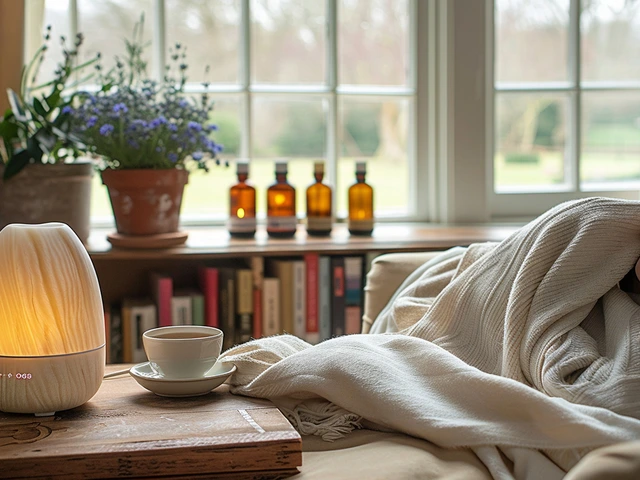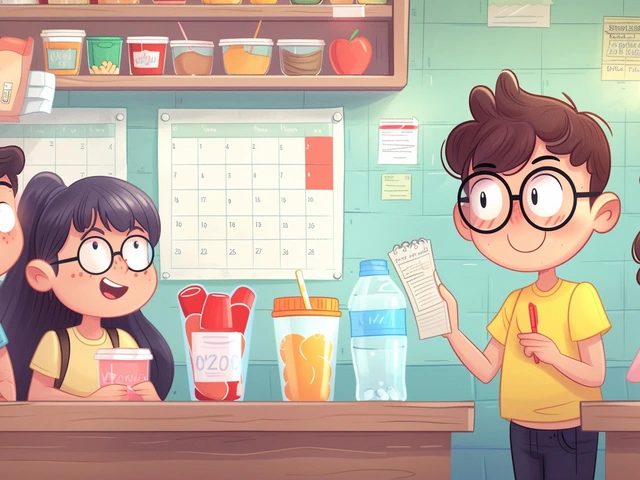Imagine stepping into a room filled with paints, brushes, and canvases, or perhaps musical instruments and clay. This is not just an art studio; it's a therapeutic space where every creation aids in healing the mind and spirit. Art therapy, a compelling blend of art and psychotherapy, harnesses the power of creative expression to help individuals confront their emotions, work through traumatic experiences, and boost mental health.
Unlike traditional psychotherapy that relies heavily on verbal communication, art therapy provides a non-verbal outlet where emotions and thoughts can be expressed through creative work. It is particularly impactful for those who find it hard to put feelings into words. This introductory guide explores how this form of therapy is helping people rebuild their lives from the inside out.
- What is Art Therapy?
- Benefits of Art Therapy
- Art Forms Used in Therapy
- Real-Life Applications
- Getting Started with Art Therapy
- Future Directions in Art Therapy
What is Art Therapy?
Art therapy, as a professional form, bridges the gap between emotional healing and artistic creation. At its core, this therapeutic approach offers individuals a way to express their thoughts and feelings when words simply aren’t enough. Art therapists are trained professionals who guide participants to explore both their creativity and emotional well-being through various artistic modalities such as drawing, painting, sculpture, or even digital media. This process helps to reveal inner thoughts and feelings, promoting understanding and healing.
The approach is grounded in the belief that the process of engaging creatively activates different regions of the brain, bypassing linguistic barriers, and enabling a unique form of expression. Studies have shown that when individuals engage in creating art, it can significantly lower stress levels and improve mood. Art therapy is used extensively in many settings including hospitals, mental health clinics, schools, and rehabilitation centers, assisting individuals from all age groups and various psychological backgrounds.
During art therapy sessions, therapists encourage freedom within the creation process, allowing for the spontaneous expression that is often critically revealing. This type of therapy is seen as a non-threatening medium to unearth deep-seated emotions and is particularly valuable for those who have experienced trauma or are struggling with mental health issues such as depression or anxiety. The goal is always therapeutic revelation and emotional wellness, achieved through the meditative and introspective qualities of artistic creation.
In practical terms, art therapy sessions might look very different from one individual to another, which underscores the personalized approach of this therapeutic practice. Each session is tailored to meet the unique emotional and psychological needs of the client, providing them a safe space to explore and express themselves. This customization makes art therapy a particularly engaging and effective form of psychological treatment.
Benefits of Art Therapy
Exploring the therapeutic benefits of art, one finds a fascinating blend of emotional and psychological relief that differs vastly from conventional therapeutic approaches. Art therapy offers a multifaceted form of healing that taps into creativity, providing relief not just to the mind but also to the soul. Individuals participating in art therapy experience a spectrum of benefits that include enhanced emotional expression, reduced-stress, and significant gains in personal insight and self-awareness. The process of creating art allows them to translate complex or abstract feelings into visible forms, making it easier to address these emotions head-on.
Beyond emotional growth, art therapy has shown promise in improving cognitive functions. Engaging in these creative processes stimulates mental acuity and focuses, aiding in the recovery from cognitive impairments following injuries or neurodegenerative diseases. This stimulation is believed to activate neural pathways that can be dormant or damaged. It's a form of non-verbal communication that provides a unique platform for individuals who struggle with expressing themselves verbally to depict their emotions and thoughts through artistic expression.
Patients struggling with anxiety, depression, or post-traumatic stress disorder have found art therapy particularly useful. By focusing on the act of creation, individuals may find themselves distracted from their chronic stressors, leading to moments of peace and calm in a turbulent mental landscape. This distraction technique, known as diversion therapy, utilizes the meditative aspects of artistic creation to help lower stress levels and alleviate psychological distress.
Children and adolescents, who may not yet have the words to fully express their feelings, especially benefit from art therapy. It gives them a safe space to explore their thoughts and emotions without the fear of judgment. This form of therapy not only helps them articulate their feelings but also encourages personal development and emotional maturity, providing them with the tools to navigate complex feelings from a young age.
As part of community outreach or group therapy sessions, art therapy fosters a sense of connection among participants. It breaks down barriers between individuals who may feel isolated or disconnected from others. These group sessions encourage sharing, collaboration, and the breakdown of personal barriers, fostering an environment of support and understanding among its members.
Art Forms Used in Therapy
The realm of art therapy is beautifully diverse, incorporating numerous art forms to engage individuals in healing practices. From drawing and painting to sculpture and digital media, each form of art offers unique pathways for expression and recovery. For instance, the use of painting allows individuals to unleash their emotions through strokes and colors, making it particularly effective for those struggling with emotional suppression or anxiety. Similarly, sculpture can be a powerful medium through which to rebuild one's self image and work through physical and emotional pain.
Music therapy involves performing, listening to, or creating music to address physical, emotional, cognitive, and social needs. Music's structured yet emotive nature can facilitate connection, reminiscence, and mood improvement. Additionally, dance therapy, which incorporates movement to enhance emotional, mental, and physical integration, serves as a dynamic tool for expression and fostering social connectivity. The expressive nature of dance allows individuals to articulate feelings they might find hard to express verbally.
Digital arts including photography and video production are becoming increasingly common in therapeutic settings. By creating digital stories or photographs, clients engage in a reflective process, telling their personal stories in unique and compelling ways. This digital engagement offers a contemporary approach to catharsis and personal growth.
Ceramics and textile arts like weaving and knitting also play significant roles in art therapy. These tactile art forms help in improving motor skills, relieving stress, and can also be excellent for group therapy sessions, fostering a sense of community and shared purpose amongst participants. The repetitive motions of knitting, for example, are known to induce a meditative state, calming the mind and allowing for relaxation.
Real-Life Applications
The transformative power of art therapy is not just theoretical; it's evidenced in myriad real-life scenarios spanning from schools to hospitals and even rehabilitation centers. For instance, in educational settings, teachers and counselors integrate art therapy to help students manage stress, especially during exam periods. Students are encouraged to channel their anxiety and stress into creative activities such as drawing or sculpting, which has been observed to markedly reduce their nervousness and improve their concentration.
In the healthcare sector, hospitals have set up art therapy programs for long-term patients. Individuals battling chronic diseases find solace and distraction in expressing themselves through the arts. It is not just about keeping busy; engaging in art has proven to be a vital part of the healing process. It helps patients deal with pain, enhances their emotional resilience, and provides them a sense of control over their lives. This has been particularly effective in hospices where maintaining mental health is as crucial as physical health.
Moreover, art therapy has gained traction within mental health facilities. Clinics offering treatment for depression and anxiety are incorporating creative arts into their programs, as it allows patients to externalize their feelings that may be too difficult to articulate. Art therapy serves as a bridge that connects therapists and patients in a uniquely expressive and non-threatening way. There is a significant body of evidence suggesting that integrating art with traditional mental health treatments catalyzes the recovery process.
Art therapy has also proved to be a beneficial tool in the rehabilitation of offenders. Correctional facilities have employed art therapy to not only reduce recidivism but also to aid inmates in exploring empathy, improving self-esteem, and planning for a future outside the prison walls. Through structured art programs, inmates reflect on their personal experiences and often confront emotional issues that may have contributed to their criminal behavior, paving the way for emotional healing and behavioral change.
Ultimately, the increasing incorporation of art therapy in diverse settings underscores its versatility and efficacy in fostering emotional growth and healing across different segments of society. Whether it is helping students combat stress, aiding patient recovery in hospitals, facilitating mental health treatment, or assisting in the rehabilitation of offenders, the impacts are profound and multi-faceted.
Getting Started with Art Therapy
Embarking on the journey of art therapy can feel as exploratory and liberating as picking up a brush for the first time. For those curious about integrating this therapy into their life, getting started involves understanding what art therapy entails and how it could be beneficial. This process often starts with self-reflection about what one hopes to achieve through therapy—whether it's dealing with grief, managing stress, or simply seeking a deeper understanding of oneself. The therapeutic alliance, formed between the therapist and the participant, relies heavily on trust and openness, which are cultivated over consistent sessions.
Finding the right art therapist is crucial. Licensed professionals who are trained specifically in art therapy possess a keen understanding of how to guide individuals through the creative process to foster healing. In many regions, art therapists are required to be registered with a professional body that ensures they meet practice standards and ethical guidelines. Researching therapists’ credentials and reading reviews can be helpful in choosing a suitable professional. Similarly, determining whether one feels comfortable with a therapist's style and approach during initial consultations is advisable.
Preparing for the first session can involve both practical and emotional considerations. On a practical level, individuals may be invited to bring items or think about themes they wish to explore through art. Emotionally, entering an art therapy session can stir up anticipation and nervousness. Acknowledging and accepting these feelings as part of the process is important. During sessions, therapists encourage clients to express whatever comes up, using art materials to externalize and examine their emotions.
Art therapy is not confined to any single medium. From painting and drawing to sculpting and digital art, therapists may incorporate a variety of artistic expressions based on what resonates best with the client. This flexibility allows individuals to explore different mediums and discover new ways of expressing themselves, which can be incredibly empowering. The choice of medium often evolves as the sessions progress, adapted to the individual’s emotional discoveries and therapeutic needs.
Integration of art therapy practices at home may also be suggested by therapists to enhance the therapeutic effects. This might involve assigned tasks like creating a daily journal, constructing mood boards, or engaging in music therapy sessions. Such at-home practices help maintain the continuity of therapeutic effects and deepen the individual’s engagement with their creative processes.
Future Directions in Art Therapy
As we gaze ahead into the future of art therapy, the horizon is as colorful and varied as a painter's palette. This field continues to evolve, integrating new technologies and methodologies that expand reach and effectiveness. Virtual reality (VR), for instance, is emerging as a groundbreaking tool in art therapy. By creating immersive 3D environments, VR enables therapists to reach patients in novel ways, facilitating deeply personal experiences that might not be possible in traditional settings. Moreover, research into neuroplasticity—the brain's ability to reorganize itself by forming new neural connections—promises to tailor art therapy even more closely to individual brain patterns, enhancing therapeutic outcomes.
Another promising area is the greater incorporation of multicultural arts. Art therapy is becoming a global discipline, drawing on diverse cultural expressions to enrich therapy sessions. This globalization of the palette acknowledges that different cultures express emotions and handle mental health differently, and by tapping into a broader spectrum of artistic expressions, therapists can offer more personalized care. Additionally, as recognition of the benefits of art therapy grows, we see greater advocacy for its inclusion in standard healthcare and educational systems. This could mean policies that support art therapy programs in schools, hospitals, and community centers, potentially making it accessible to a much wider audience.
Furthermore, partnerships between art therapists and other professionals—such as educators, psychologists, and social workers—are enhancing interdisciplinary approaches. These collaborations are not only broadening the scope but are also deepening the understanding of art as a therapeutic tool. With each shared experience and every studied outcome, art therapy is carving a niche for itself as an essential part of holistic health practices. Looking to the future, we anticipate that art therapy will continue to innovate and inspire, aiding more individuals in expressing the unspoken and understanding the tangled web of human emotions.
The potential for art therapy to serve as a beacon of hope and transformation in an increasingly complex world is immense. As we look forward, the integration of art with scientific and technological advancements holds the promise of developing therapeutic practices that are not only creative but also highly effective, setting a new standard for what healing looks like in the modern age.






Write a comment: